Devonshire House Skin Clinic
[9 miles from Galleywood]
Welcome to the Award-Winning Devonshire House Skin Clinic, Our Pioneering Skin Health Treatment Clinic.[READ MORE]
24a High Street, Brentwood, CM14 4AB

In our comprehensive list, you will find all the best, trustworthy Electrolysis (Advanced Cosmetic Procedures) clinics near Galleywood.
We only allow verified and accredited clinics that are registered with the appropriate governing bodies so you can TRUST the experts at ConsultingRoom.com to find your ideal clinic in Galleywood.
For information on Electrolysis (Advanced Cosmetic Procedures) please Click Here to view our comprehensive treatment FAQ, or to book a consultation contact your chosen clinic from the list directly.
[9 miles from Galleywood]
Welcome to the Award-Winning Devonshire House Skin Clinic, Our Pioneering Skin Health Treatment Clinic.[READ MORE]
24a High Street, Brentwood, CM14 4AB
[34 miles from Galleywood]
At the Skin Care Clinic, we bring together highly effective treatments and trusted, medical grade skin care products to create and deliver your personalised treatment plan. Lead by a very experien...[READ MORE]
38 Watling Street, Radlett, Hertfordshire, WD7 7NN
[36 miles from Galleywood]
The AL5 Aesthetics clinic is a luxury aesthetics medi Spa in harpenden, herts offering a wide variety of cutting edge and bespoke face and body treatments and training courses.[READ MORE]
Westley House, 42 Cold Harbour Lane, Harpenden, AL5 4UN
[38 miles from Galleywood]
Tocolo offers a range of handpicked skin rejuvenation treatments with the aim of making you look and feel your very best. Tocolo is a discrete aesthetic cosmetic service that covers Watford and s...[READ MORE]
33 The Crescent, Abbots Langley, WD5 0DR
[40 miles from Galleywood]
The Cosmetic Laser Clini, Ipswich, Suffolk offers a wide range of Laser treatments including Q-Switched Tattoo Removal, Laser Hair Removal, Skin Resurfacing, Pigmentation,Thread vein for face/Legs...[READ MORE]
The Lodge, Tuddenham Road, Ipswich, IP4 3QH
Electrolysis (Advanced Cosmetic Procedures) FAQ
In 1875 the very first treatment using electrolysis was recorded in ‘The Lancet’ for trichiasis (in-growing eyelashes). Since this time, further developments have established its position as a successful and popular treatment for permanent hair removal for both medical and cosmetic reasons. Indeed it still is the only form of permanent hair removal that works for all skin and hair types and colours legally allowed to make that claim.
Advanced electrolysis, referred to as Advanced Cosmetic Procedures uses electrolysis to treat various types of 'lumps and bumps' such as warts, skin tags, moles and other benign growths, as well as thread veins and vascular conditions. It is historically considered a relatively new development but the book, ‘Electricity in Facial Blemishes’ by Plym S Hayes M.D. (the late professor of chemistry and toxicology at the Chicago College of Pharmacy), published in 1910, suggested that many of the treatments have been around almost as long as electrolysis hair removal.
His book featured electrolysis treatment of many blemishes including:
“port-wine marks, pigmentary naevi, fibromata (small, benigh tumours of fibrous tissue), naevus verrucosus and warts, naevus vasculosus simplex, angioma cavernosum, telangiectasis (thread veins), naevus araneous (spider nevus) and even xanthoma palpebera (small yellowy lumps common around the eyes).”
So historically the effective results of electrolysis were quickly put to other uses and its true versatility was recognised in the development of techniques for the treatment of a number of minor skin conditions and imperfections. Other treatments have been added to Hayne’s impressive list and techniques honed and improved for other conditions such as sebaceous cysts (a swelling in the sebaceous gland caused by a blockage and accumulated sebum) and syringoma (harmless sweat duct tumours common on the eyelids and armpits) to mention just a few.
There are now over 21 different types of blemishes that can be safely and effectively treated using electrolysis.
If you are considering electrolysis for advanced cosmetic procedures for various minor skin problems, the following information will give you a basic understanding of the procedure and the types of conditions which can be addressed using this technique. It can't answer all your questions, since a lot depends on the particular skin complaint. Please ask a practitioner about anything you don't understand.
Advanced Cosmetic Procedures is a new name for ‘Advanced Electrolysis’ plus all the new additional techniques which have now been developed. This speciality treatment uses either Short Wave Diathermy (High Frequency A/C) or Blend (a mixture of A/C and D/C) to treat unwanted skin blemishes with no mark left on the skin.
Advanced Cosmetic Procedures was defined to avoid any confusion in thinking that “Advanced Electrolysis” was simply an advanced form of hair removal. The term, Advanced Cosmetic Procedures (ACP), encompassed far more effectively, the wide variety of treatable skin conditions.
Treatable skin conditions include:
...and the list gets longer and longer as more research and development is carried out.
The first recorded use of electrolysis in the 19th Century used a galvanic treatment method. The use of electrolysis for hair removal continued through the early part of the 20th century. More developments in the field of electrolysis followed, including the use of many needles and a different form of electricity treatment which uses heat damage to destroy the hair follicle. This method is called diathermy, thermolysis, or short wave.
Improvements in the equipment and techniques for performing electrolysis have come about in recent years. Now, diathermy and the galvanic method are combined to give the best possible results.
Although there have been significant improvements in the equipment used, electrolysis and particularly advanced electrolysis remains highly dependent on the skill of the practitioner. Be sure to ask your practitioner for evidence of additional and ongoing electrolysis training.
Galvanic electrolysis
The galvanic method works by using a Direct Current (DC) of electricity. When the needle is inserted, the electricity coming down the needle causes the salt and water in the skin around the probe to be chemically altered. Salt, water and electricity combine to produce a small amount of sodium hydroxide. If enough is produced, this solution can damage the cells, in particular those that cause hair growth.
Thermolysis/Diathermy/Short Wave Electrolysis
The thermolysis method, also known as diathermy or short wave, works by using an Alternating Current (AC) of electricity. This electricity causes the water molecules in the skin around the needle to vibrate, which creates heat. If enough heat is produced, it can damage the cells that it is targeting.
Blend Electrolysis
The Blend Method combines both the Short Wave and Galvanic procedures. Sodium hydroxide is created and is then heated by the electricity. This heat, plus the chemical solution, then destroys tissue.
Properly used, all the methods described above are capable of the same result in most advanced applications.
In your first appointment with a practitioner, you should clearly explain your expectations of the advanced cosmetic procedure treatment. Your practitioner should then tell you whether this is the right treatment for you and whether it can achieve the results you’d like.
Make sure that you obtain as much information as necessary to enable you to make a fully informed decision about this procedure. You should also find out about other treatment options, such as radiosurgery before you decide to go ahead with any treatment.
The practitioner should also ask for your medical history to make sure that there are no reasons why you shouldn’t undergo electrolysis treatment. At this point, you would also normally be asked to sign a consent form which means that you have understood the future benefits and possible risks associated with the procedure.
Photographs of the area to be treated may also be taken by the practitioner for a “before and after” comparison later.
Procedure
An anaesthetic cream is usually first applied to the area to be treated to help reduce pain. The electrologist then touches a wire/filament called a probe and sometimes also referred to as a needle against or within the skin abnormality to cauterise and/or cosmetically reduce the vascular or abnormal growth.
Details on what happens when treating individual conditions is available further down this FAQ.
Repeat procedures
Normally it is not necessary to have repeat treatments once an abnormality has been treated, however if you are prone to a particular skin condition formation then new 'lumps' may appear in the future which themselves can be treated.
A course of advanced electrolysis is often advised for telangiectasia so that treatments can be spaced out to prevent skin damage or hyper-pigmentation.
Some conditions can be quite resilient and more than one treatment may be necessary, your practitioner will advise based on the response noted.
The amount of treatment time that may be required for different areas is extremely variable depending on the skin condition and the proliferation of its effect.
A Greek word meaning ‘end vessel dilation’. These are not ‘broken capillaries’ as so often named, but permanently dilated capillaries. The thin, singular cell wall structure of the fine facial capillaries dilate and constrict constantly in order to control the body temperature and their elasticity weakens and they can become permanently dilated. Their visibility is often exacerbated by the breakdown of the skin’s supporting network of collagen and elastin and ageing, thinning skin.
There are numerous causes for Telangiectasia including: ageing, hereditary and genetic causes, pregnancy, hormones, general skin fragility, smoking, extreme sports, temperature extremes and harsh weather exposure. They are very commonly seen in a maturing ‘English rose’ complexion.
A course of advanced electrolysis is often advised for telangiectasia so that treatments can be spaced out to prevent skin damage or hyper-pigmentation. Both Thermolysis and blend methods can be utilised, but the latter is only taught by a few specialists in this field. Diathermy is more commonly used, which involves a very accurate positioning of the probe over the blood vessel and a gentle tap that applies current to the skin’s surface. This causes that tiny section of vessel to immediately disappear. Treatment sessions are usually for example 15 minutes per cheek.
Although not considered a cause of telangiectasia, rosacea (and the medication for it) may be a related factor, with the two conditions often presenting simultaneously. Reducing the appearance of the blood vessels using electrolysis may initially trigger a rosacea attack. However this is relatively rare and only a temporary consequence of the long-term positive results.
Named after Campbell Grieg De Morgan (1811-1876) a British surgeon who was the first to note them, in medical literature these vascular blemishes are also known as Cherry Angioma or Blood Spots. They present themselves as slightly raised or dome shaped and are of unknown origin. They are mostly seen on the trunk in middle aged and elderly clients and are even more common in men than women. They are treated with Diathermy only. Larger ones (50p size+) will need more than one treatment. Smaller ones often disappear at time of treatment.
Spider Naevus a central dilated blood vessel, with smaller capillaries radiating from it like the legs of a spider can be individual isolated blemishes or can be multiple in areas such as the cheeks or chest area. They can, if apparent in isolation, be a result of a trauma to the skin, for example…. a child following a minor mishap such as bumping into an object, can develop a spider naevus in the traumatised area. Certain conditions can make them worse including extreme heat and cold, obesity, pregnancy, stress or pressure on the area. Several spider naevus appearing spontaneously is a cause for concern as it might indicate liver disease. They can be treated with Blend or Diathermy methods although they can be quite resilient and more than one treatment may be necessary.

Skin Tags are a common fibrous skin condition commonly found in areas of friction such as the armpits, under the breasts, groin or around the neck where necklaces or collars may irritate. Derived from epithelial cells and consisting of loose fibrous tissue they form single or multiple distributions and are often hyper-pigmented making them more obvious. They often present with a neck like a mushroom and vary in size from a tiny speck, smaller than a grain of uncooked rice, to the size of a large pea or larger. They are viral in nature (Human Papilloma Virus HPV) and whilst not infectious they can proliferate on individuals with some people suffering from hundreds of them.
Skin Tags are very easily treated using advanced electrolysis techniques and whether they are tiny ones between the eyelashes or large ones under the arms there is one of the advanced electrolysis techniques suitable for them. Areas of friction such as the under the breasts and under folds of skin on the overweight are very common areas to find these irritating blemishes. Advanced electrolysis is probably the quickest, easiest way of removing the problem in a safe and effective manner.
There are three different methods of skin tag removal for different types of tags and location:
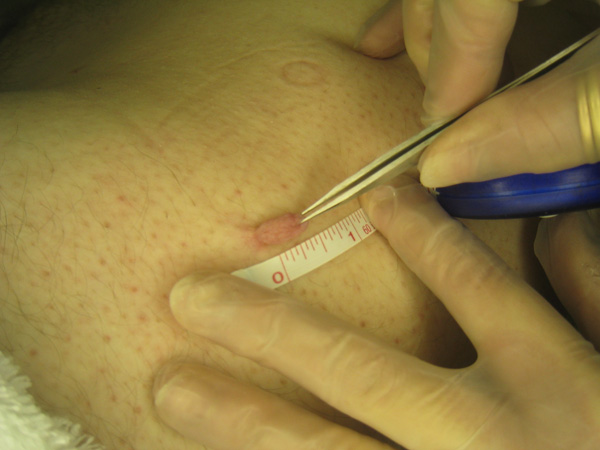
Step 1
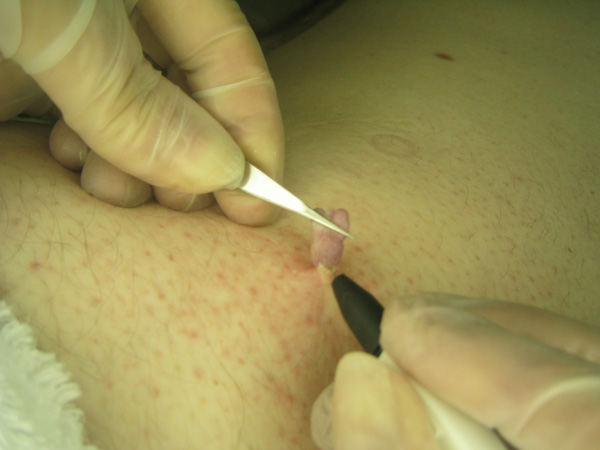
Step 2
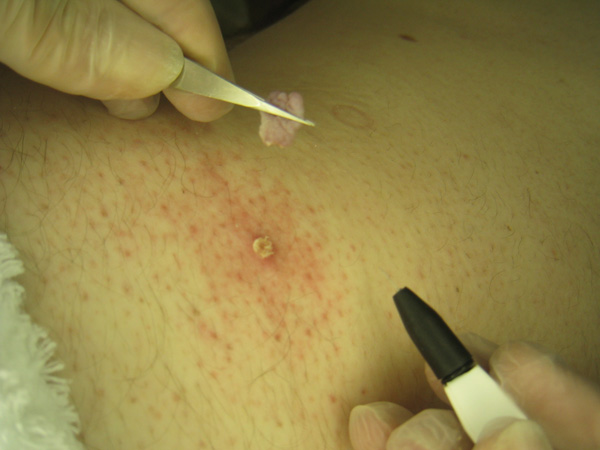
Step 3
Lying very superficially under the epidermis milia present themselves as small white lipid-epithelium plugs which contain lamellated keratin deposits and often show as hard, solid lumps lying in the superficial papillary dermis. They are a retention of keratin and sebaceous material within the pilosebaceous duct, eccrine sweat duct, or the sebaceous collar surrounding vellus hair. Their exact cause is unknown although they are often related to diet with a high cholesterol count, excessive Vitamin C, too rich moisturising cream and are also associated with dry skin which can be acidic.
They can all be treated easily with advanced electrolysis techniques using diathermy (AC) which gently dries them up so that the hard keratinised centre is broken down and this will then be absorbed by the skin following treatment. This is a much gentler way to treat them, as opposed to removing them with a microlance, which can damage the skin. Milia can appear between the eyelashes, on the eyelid itself, the cheek area or anywhere on the face or neck where dry skin is present. They tend to grow in size, become harder (as the contents keratinize) and then become noticeable to the eye and cosmetically unattractive. Some people may only suffer one and others exhibit a proliferation of up to 40 – 60 of them at any one time.
There are various types of warts, including flat (plane) raised (common) and verrucas (plantar - on the feet). They are benign epidermal tumours which are contagious (human papilloma virus) and all can be treated. Warts can develop individually or in clusters and can spontaneously disappear. Plane or flat warts occur mostly on the face, backs of hands and wrists. Hygiene must be of the highest importance to avoid cross infection and if not treated they may spread. Treatment is performed using diathermy.
Seborrhoeic Keratosis classified within the wart family but these differ in the fact that they are not contagious. They present as raised and appear frequently as several lesions on covered body sites and are also quite common on the face in older people. They are usually brown because of melanin and so can be mistaken for moles to the untrained eye. The dry, scaly, crusty appearance often with a cleft surface and a superficial ‘stuck on’ appearance are helpful identification points. They can be tiny or large even up to two inches across and can be removed with diathermy (AC) simply and effectively.
Dermatosis Papulosa Nigra is peculiar to black skin and is a common papular disorder which develops in adolescence. The lesions are histologically identical to seborrhoea keratosis and present as smooth, dome shaped, brown to black papules seen mainly on the cheeks, neck and upper chest. These are generally a very common disorder and the famous actor Morgan Freeman has many of these on his face. They are very easily and successfully treated using diathermy and advanced electrolysis techniques.
Hairs from moles are easily treated by those trained in advanced electrolysis techniques. Once treatment is started it is normal for the mole to reduce in size and colour. Hairs in moles are generally deep terminal hairs with a very rich blood and nerve supply to them. Repeat treatments, as with hair removal electrolysis are required and blend or diathermy can be used.
A mole itself is easily treated but rather than ‘removing’ we ‘visibly reduce the appearance’ of the mole. A number of techniques are used all using diathermy (AC). The first treatment will visibly reduce the mole by up to three quarters of its size and then a follow up treatment can smooth it so that it is flat to the skin. The colour can never be guaranteed to exactly match the surrounding skin but if the mole is much darker the remaining skin, following treatment, will almost certainly be lighter.
Age Spots are caused by an accumulation of a yellow pigment called lipofuscin from ageing of the collagen producing cells. They are very common on the hands and face of middle aged and elderly patients and are usually despised by them as they are so recognisably a sign of increasing age. Chemical peels and skin whitening products are commonly used for treatment but electrolysis is also very effective. Using a very fine electrolysis needle and diathermy (AC) current a tiny section of the age spot is lifted from the underlying tissue and the colour underneath is observed. If the tiny area exposed is lighter in colour removal can go ahead with varying degrees of success. If the pigment underneath the tiny section lifted is the same colour as the age spot itself the pigment goes deep into the dermis and treatment will not be successful.
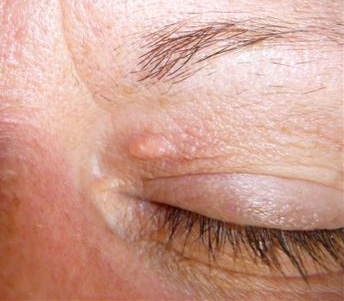
Xanthomas are deposits of fatty material under the skin and range in size from 6mm to more than 7cm diameter. They are associated with a symptom of metabolic disorders such as diabetes or high cholesterol.
Xanthelasma Palpebera is the common type which appears on the eyelids and presents itself as flat yellowish growths on the eyelid close to the nose. Resembling a butter bean and causing no pain they are successfully treated using Diathermy. They reduce in size and appearance although the milky yellowy colour remains and more than one treatment is often required over a period of time.
Syringomas are benign eccrine gland tumours presenting as flattish papules or plates found around the eye socket area in particular under the eye and are non-contagious flesh colour elevations of the skin. They range from 1–3 mm in diameter and are firm to the touch. They are easily treated with diathermy and advanced electrolysis techniques.
This is a common condition of small ‘warty pearly’ white or slightly pink lumps on the skin each lump being round, firm and about 1-5mm across. It is a contagious virus and typically each molluscum lasts about 6-12 weeks, crusts over and then goes. New ones tend to appear as old ones fade as the virus spreads to other areas of skin. Therefore ‘crops’ appear and go for several months and it can take 12-18 months before the last goes completely. Electrolysis using diathermy can be successfully utilised to desiccate each molluscum.
Sebaceous Cyst or (Steatoma) is retention of keratin trapped under the surface of the skin trapped within a sebaceous sac which is created from skin cells. They are painless, slow-growing, small bumps or lumps that move freely under the skin and to the trained eye, are usually easily diagnosed by their appearance.
Sebaceous cysts are formed often due to swollen hair follicles, blocked glands, skin trauma and higher levels of testosterone in the body. Keratin is an extremely strong protein found naturally within the body and is a major component in skin, hair, nails and teeth. It is predominantly made up of dead cells and amino acids which combine to form keratin and these contain unique properties rendering it hard or soft. If the dead cells are kept in good condition, they will serve as an insulating layer to protect the delicate new keratin below them.
The size of the cyst can vary from a pea to an egg, and the areas most affected are those where there are more sebaceous glands, i.e. face, chest, scalp and back, although sometimes they also appear in the underarm and can be found on the trunk and the vaginal area or other parts of the genitalia. They may have an open or closed top and treatment is dependent upon the size and location.
If small, the most gentle and least invasive method is electrolysis which is proving very successful. If electrolysis is performed it may be necessary to treat the nodule more than once depending on its size and location and successful treatment cannot always be guaranteed as every cyst is very individual in nature.
An electrolysis needle is inserted into the sebaceous cyst a number of times and the A/C, RF diathermy current is expelled and held within the skin overgrowth. The heat softens the contents of the cyst and immediately following the application of the current the contents (or some of the contents) may be able to be excised from the nodule. This, however, is not always the case and apart from generalised erythema (redness) the nodule may not look any different initially following treatment. Over the next week or so the nodule should reduce in size, irrespective of whether contents are expelled. Further treatment will almost certainly be required and no guarantees offered, however positive feedback is forthcoming from those treated by the use of electrolysis.
No recovery time as such is necessary. You can return to work and normal activities immediately after a treatment.
Depending on the particular skin condition being treated and the size of it, you can expect some post treatment discomfort and scabbing as the area heals.
If the area being treated is on your face, you may wish to plan treatment around social events if you do not wish to attend them before post-treatment healing has completed.
When the treatments are performed correctly there is little or no chance of permanently marking the skin.
Some clinics recommend, when appropriate, to try a ‘tester patch’ in an area which is not too noticeable in case of adverse reaction. This also allows you to ‘experience’ the feel of the treatment, to see the benefits and for the practitioner to access your healing rate. This is not a requirement for treatment though.
With many of the procedures the appearance may look worse before it looks better so careful ‘timing’ of the treatment should be considered, particularly if you have any special events in your calendar and the treated area is in a noticeable place, such as on your face.
The Short Wave Diathermy method has always been popular and is still commonly used for many of the procedures but the Blend method of Telangiectasia, is a more gentle treatment causing less skin trauma and resulting in quicker healing. You may wish to ask the clinic which method they use.
It is very important that you follow the advice of your practitioner carefully after electrolysis for advanced cosmetic procedures to reduce the risk of any complications.
Post-treatment advice may include:
As long as you are generally healthy and don’t have any skin diseases or active infections in the area being treated, there are few medical reasons why patients should not undergo this treatment.
An experienced practitioner will be able to identify if a particular abnormality should not be treated and refer you for further evaluation in cases of suspected malignancies or skin cancers.
Although there is no evidence that this treatment is harmful for pregnant women, you may be advised to wait until after you have given birth before embarking upon treatment.
All members of the medical profession (Doctors, Nurses etc.), and suitably advanced trained and qualified beauty therapists, can perform this procedure depending on the complexity of the skin condition being treated. If you think you have an undiagnosed dermatological condition, we would recommend seeing a medical professional for treatment.
The demarcation line between medical and beauty is becoming very hazy. Due to lack of funding, practitioners within the NHS are now not performing any treatments considered ‘cosmetic’ so consumers must actively look for an alternative via a private clinic.
It is highly unlikely that anyone considering advanced cosmetic procedure treatment with electrolysis would be able to access this free of charge on the National Health Service for a benign, cosmetic indication.
However, depending upon your skin concern, particularly if a defect is growing or changing rapidly, changing shape, colour or starting to bleed, it is worth visiting your General Practitioner before embarking upon a search for private treatment as a referral may be needed to rule out any medical issues such as pre-cancerous conditions.
With advanced cosmetic procedures generally you pay for the length of time in which you are treated and this varies depending on the clinic, practitioner and the area or condition being targeted.
Expect to pay £50 - £70 for 15 minutes and £85 - £120 for 30 minutes for a beauty therapist/electrologist to perform these treatments but qualified Nurses, Doctors and Cosmetic Surgeons charge more, depending on the level of qualification of the practitioner and the indication being treated.
Advanced electrolysis is a useful technique for advanced cosmetic procedures which treat a variety of small skin conditions and abnormal growths both quickly and efficiently. Results are often considered to be very good, with little to no marks left on the skin when done by experienced practitioners and are usually permanent in nature. Both men and women, and all skin types (colours) can benefit from it, with extra care taken by the practitioner on those individuals with dark skin.
Please note that results of non-surgical treatments vary enormously, depending upon both the patient and the skill of the individual practitioner.
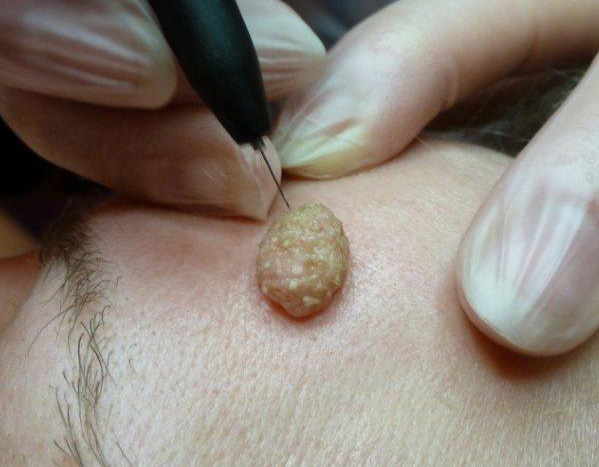
Hairy mole before treatment
One month after treatment
Final result
Images provided courtesy of Sterex Electrolysis International Limited.
All before and after photographs are real patients, your results may differ.
We often get asked "Where can I get Electrolysis (Advanced Cosmetic Procedures) near me", so we have listed local areas where Electrolysis (Advanced Cosmetic Procedures) clinics are located.